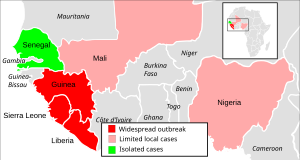West African Ebola virus epidemic

Simplified Ebola virus epidemic situation map
|
|||||||||||||||||||||||||||||||||||||||||||||||||
| Date | December 2013 – June 2016 | ||||||||||||||||||||||||||||||||||||||||||||||||
|---|---|---|---|---|---|---|---|---|---|---|---|---|---|---|---|---|---|---|---|---|---|---|---|---|---|---|---|---|---|---|---|---|---|---|---|---|---|---|---|---|---|---|---|---|---|---|---|---|---|
|
|||||||||||||||||||||||||||||||||||||||||||||||||
The West African Ebola virus epidemic (2013–2016) was the most widespread outbreak of Ebola virus disease (EVD) in history—causing major loss of life and socioeconomic disruption in the region, mainly in the countries of Guinea, Liberia, and Sierra Leone. The first cases were recorded in Guinea in December 2013; later, the disease spread to neighboring Liberia and Sierra Leone, with minor outbreaks occurring elsewhere. It caused significant mortality, with the case fatality rate reported at slightly above 70%, while the rate among hospitalized patients was 57–59%. Small outbreaks occurred in Nigeria and Mali, and isolated cases were recorded in Senegal, the United Kingdom and Sardinia. In addition, imported cases led to secondary infection of medical workers in the United States and Spain but did not spread further. The number of cases peaked in October 2014 and then began to decline gradually, following the commitment of substantial international resources. As of 8 May 2016[update], the World Health Organization (WHO) and respective governments reported a total of 28,616 suspected cases and 11,310 deaths (39.5%), though the WHO believes that this substantially understates the magnitude of the outbreak.
On 29 March 2016, the WHO terminated the Public Health Emergency of International Concern status of the outbreak. Subsequent flare-ups occurred; the last was declared over on 9 June 2016, 42 days after the last case tested negative on 28 April 2016 in Monrovia.
The outbreak left about 17,000 survivors of the disease, many of whom report post-recovery symptoms termed post-Ebola syndrome, often severe enough to require medical care for months or even years. An additional cause for concern is the apparent ability of the virus to "hide" in a recovered survivor's body for an extended period of time and then become active months or years later, either in the same individual or in a sexual partner. In December 2016, the WHO announced that a two-year trial of the vaccine rVSV-ZEBOV appeared to offer protection from the strain of Ebola responsible for the West Africa outbreak. The vaccine has not yet had regulatory approval, but it is considered to be so effective that 300,000 doses have already been stockpiled.
...
Wikipedia
